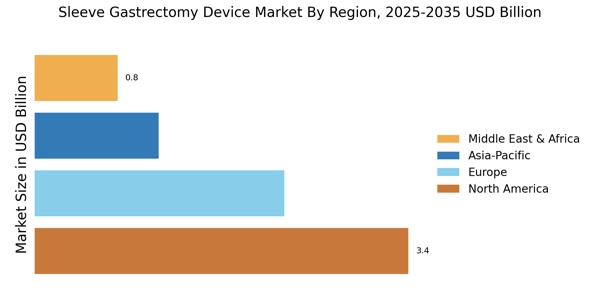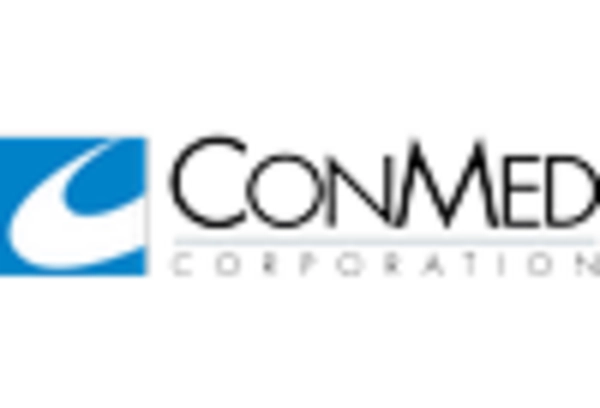The Sleeve Gastrectomy Device Market is currently characterized by a dynamic competitive landscape, driven by increasing obesity rates and a growing demand for minimally invasive surgical options. Key players such as Medtronic (US), Johnson & Johnson (US), and Intuitive Surgical (US) are strategically positioned to leverage their technological advancements and extensive distribution networks. Medtronic (US) focuses on innovation in surgical devices, while Johnson & Johnson (US) emphasizes partnerships to enhance its product offerings. Intuitive Surgical (US) is known for its robotic-assisted surgical systems, which are becoming increasingly relevant in bariatric procedures. Collectively, these strategies contribute to a competitive environment that is both innovative and responsive to market needs.
In terms of business tactics, companies are increasingly localizing manufacturing to reduce costs and improve supply chain efficiency. The market appears moderately fragmented, with several players vying for market share. However, the influence of major companies is significant, as they set industry standards and drive technological advancements. This competitive structure allows for a diverse range of products and services, catering to various patient needs and preferences.
In August 2025, Medtronic (US) announced the launch of a new sleeve gastrectomy device that incorporates advanced imaging technology to enhance surgical precision. This strategic move is likely to position Medtronic as a leader in the market, as it addresses the growing demand for improved surgical outcomes and patient safety. The integration of imaging technology into surgical devices may also set a new benchmark for competitors, pushing them to innovate further.
In September 2025, Johnson & Johnson (US) expanded its partnership with a leading telehealth provider to offer remote patient monitoring solutions for bariatric surgery patients. This initiative reflects a growing trend towards digital health solutions, which are becoming essential in managing patient care post-surgery. By enhancing patient engagement and monitoring, Johnson & Johnson (US) is likely to improve surgical outcomes and patient satisfaction, thereby strengthening its market position.
In October 2025, Intuitive Surgical (US) unveiled a new training program for surgeons focusing on robotic-assisted sleeve gastrectomy procedures. This program aims to enhance the skill set of surgeons and improve patient outcomes. By investing in education and training, Intuitive Surgical (US) not only reinforces its commitment to quality but also fosters loyalty among healthcare professionals, which could translate into increased adoption of its technologies.
As of October 2025, the competitive trends in the Sleeve Gastrectomy Device Market are increasingly defined by digitalization, sustainability, and the integration of artificial intelligence. Strategic alliances are becoming more prevalent, as companies recognize the value of collaboration in enhancing their technological capabilities. Looking ahead, competitive differentiation is likely to evolve from traditional price-based competition to a focus on innovation, advanced technology, and reliable supply chains. This shift may ultimately lead to improved patient outcomes and a more sustainable market environment.


















Leave a Comment